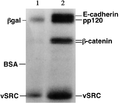Gel electrophoresis
Gel electrophoresis is a method used in laboratory settings to separate DNA, RNA, or protein molecules based on their size and charge. This technique is commonly used in molecular biology, biochemistry, and genetics laboratories.
Overview[edit]
Gel electrophoresis works by applying an electric field to a gel that contains the molecules of interest. The molecules will move through the gel at different rates depending on their size and charge, allowing them to be separated.
Process[edit]
The process of gel electrophoresis involves several steps:
- Preparation of the gel: The gel is typically made from agarose or polyacrylamide, which are substances that create a matrix through which the molecules can move.
- Loading the samples: The DNA, RNA, or protein samples are loaded into wells in the gel.
- Applying the electric field: An electric field is applied to the gel, causing the molecules to move through the gel. The direction of movement will depend on the charge of the molecules.
- Staining and visualization: After the electrophoresis is complete, the gel is stained to make the bands of molecules visible. The gel can then be photographed or otherwise recorded for further analysis.
Applications[edit]
Gel electrophoresis has a wide range of applications in the field of molecular biology and genetics. It is used in DNA sequencing, genotyping, mutation detection, and protein purification, among other things.
See also[edit]
References[edit]
<references />
|
|
|
-
Gel electrophoresis apparatus
-
Diagram of gel electrophoresis
-
Gel electrophoresis in DNA fingerprinting
-
SDS-PAGE electrophoresis
-
Gel electrophoresis insert comb
-
TTGE profiles representing bifidobacterial diversity
-
Glucose-6-Phosphate Dehydrogenase activity stain
-
PCR gel
-
SDS-PAGE
Ad. Transform your life with W8MD's Budget GLP-1 injections from $75


W8MD offers a medical weight loss program to lose weight in Philadelphia. Our physician-supervised medical weight loss provides:
- Weight loss injections in NYC (generic and brand names):
- Zepbound / Mounjaro, Wegovy / Ozempic, Saxenda
- Most insurances accepted or discounted self-pay rates. We will obtain insurance prior authorizations if needed.
- Generic GLP1 weight loss injections from $75 for the starting dose.
- Also offer prescription weight loss medications including Phentermine, Qsymia, Diethylpropion, Contrave etc.
NYC weight loss doctor appointmentsNYC weight loss doctor appointments
Start your NYC weight loss journey today at our NYC medical weight loss and Philadelphia medical weight loss clinics.
- Call 718-946-5500 to lose weight in NYC or for medical weight loss in Philadelphia 215-676-2334.
- Tags:NYC medical weight loss, Philadelphia lose weight Zepbound NYC, Budget GLP1 weight loss injections, Wegovy Philadelphia, Wegovy NYC, Philadelphia medical weight loss, Brookly weight loss and Wegovy NYC
|
WikiMD's Wellness Encyclopedia |
| Let Food Be Thy Medicine Medicine Thy Food - Hippocrates |
Medical Disclaimer: WikiMD is not a substitute for professional medical advice. The information on WikiMD is provided as an information resource only, may be incorrect, outdated or misleading, and is not to be used or relied on for any diagnostic or treatment purposes. Please consult your health care provider before making any healthcare decisions or for guidance about a specific medical condition. WikiMD expressly disclaims responsibility, and shall have no liability, for any damages, loss, injury, or liability whatsoever suffered as a result of your reliance on the information contained in this site. By visiting this site you agree to the foregoing terms and conditions, which may from time to time be changed or supplemented by WikiMD. If you do not agree to the foregoing terms and conditions, you should not enter or use this site. See full disclaimer.
Credits:Most images are courtesy of Wikimedia commons, and templates, categories Wikipedia, licensed under CC BY SA or similar.
Translate this page: - East Asian
中文,
日本,
한국어,
South Asian
हिन्दी,
தமிழ்,
తెలుగు,
Urdu,
ಕನ್ನಡ,
Southeast Asian
Indonesian,
Vietnamese,
Thai,
မြန်မာဘာသာ,
বাংলা
European
español,
Deutsch,
français,
Greek,
português do Brasil,
polski,
română,
русский,
Nederlands,
norsk,
svenska,
suomi,
Italian
Middle Eastern & African
عربى,
Turkish,
Persian,
Hebrew,
Afrikaans,
isiZulu,
Kiswahili,
Other
Bulgarian,
Hungarian,
Czech,
Swedish,
മലയാളം,
मराठी,
ਪੰਜਾਬੀ,
ગુજરાતી,
Portuguese,
Ukrainian











